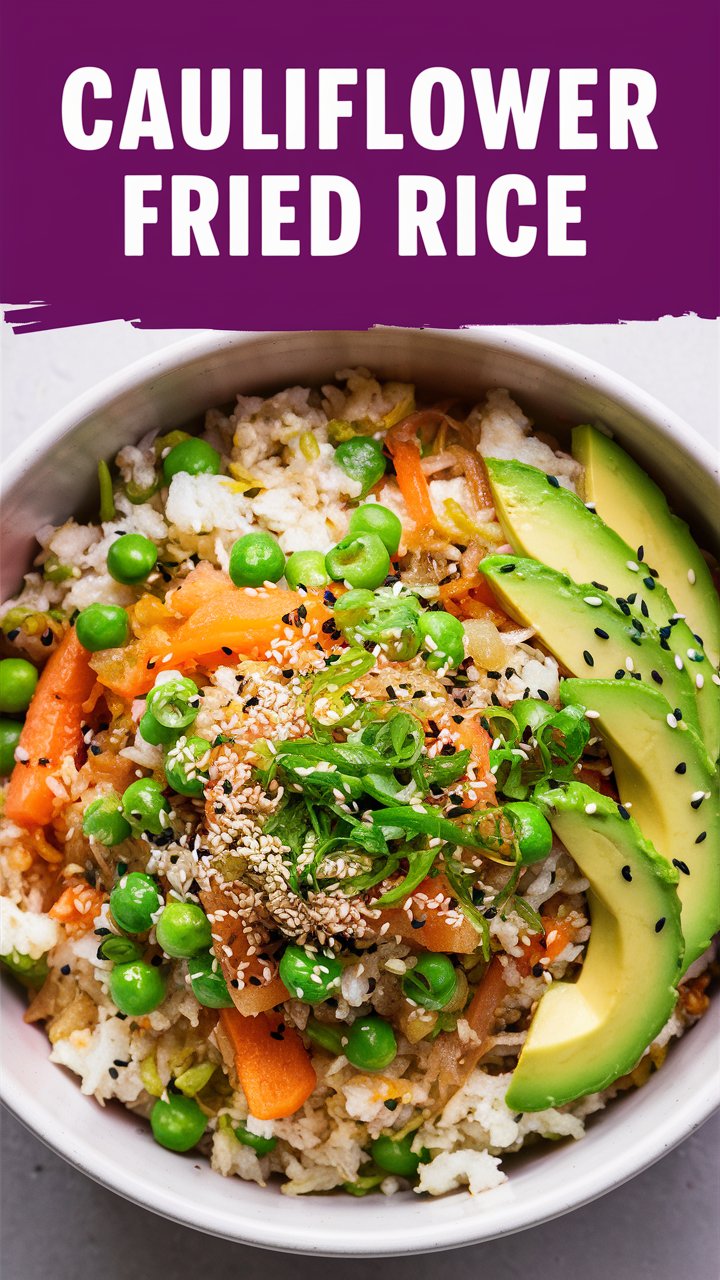There are few dishes as comforting as a warm bowl of fried rice. It’s flavorful, filling, and endlessly versatile. But for anyone following a low-carb lifestyle, managing blood sugar, or simply trying to sneak more vegetables into their daily meals, traditional fried rice can feel off-limits. That’s where cauliflower fried rice comes in—a dish that delivers all the flavor, texture, and satisfaction of fried rice while keeping things light, healthy, and nutrient-rich.
The first time many people hear about using cauliflower in place of rice, they’re skeptical. Can a cruciferous vegetable truly mimic the beloved grains of rice? The answer is yes—when prepared properly, cauliflower rice tastes remarkably similar to the real thing, absorbs flavors beautifully, and even adds nutritional benefits that traditional rice cannot match.
This guide is more than just a recipe. It’s a comprehensive resource for mastering cauliflower fried rice—covering tools, techniques, ingredient breakdowns, cooking tips, variations, nutritional benefits, and storage solutions. Whether you’re new to cauliflower rice or already a fan looking to perfect your method, you’ll find everything you need right here.
Why Choose Cauliflower Fried Rice?
1. A Smart Low-Carb Alternative
A single cup of cooked white rice contains around 40–45 grams of carbohydrates, while cauliflower rice delivers just 5–6 grams per cup. For people managing weight, blood sugar, or following low-carb or ketogenic lifestyles, this swap makes a massive difference without sacrificing enjoyment.
2. More Vegetables, More Nutrients
Cauliflower is packed with fiber, vitamin C, vitamin K, and antioxidants like sulforaphane. Unlike plain rice, it contributes to your daily vegetable intake while keeping the dish light and satisfying.
3. Versatility in Flavors and Diets
Cauliflower fried rice can be:
- Keto-friendly (use coconut aminos instead of soy sauce)
- Paleo (omit soy and use clean oils)
- Gluten-free (with the right sauces)
- Vegan (skip eggs, add tofu or tempeh)
- Kid-friendly (adjust seasonings and add extra carrots or peas)
4. Quick and Convenient
Traditional fried rice often requires leftover day-old rice. Cauliflower fried rice, on the other hand, is ready in under 30 minutes—even faster if you use pre-riced cauliflower.
Essential Kitchen Tools & Preparation Techniques
You don’t need a restaurant kitchen to make perfect cauliflower fried rice, but the right tools make all the difference.
- Food Processor: The fastest way to “rice” cauliflower into grain-sized pieces. A few pulses are all it takes.
- Box Grater: Works well if you don’t own a processor—just more hands-on effort.
- Large Wok or Skillet: Essential for high-heat cooking and preventing overcrowding.
- Sharp Chef’s Knife: For prepping vegetables, proteins, and garnishes.
- Microplane or Grater: Ideal for finely grating garlic and ginger.
- Wooden Spoon or Wok Spatula: Sturdy tools that withstand high heat and constant stirring.
🔑 Pro Tip: Avoid overcrowding the pan. Overcrowding traps steam, leading to soggy cauliflower instead of the slightly crispy, “fried” texture you want.
Ingredient Deep Dive
Each ingredient in cauliflower fried rice has a role to play. Choosing quality components ensures the dish delivers maximum flavor.
- Cauliflower: The base of the dish—neutral, absorbent, and lightly sweet.
- Sesame Oil: Adds authentic Asian aroma and nutty depth.
- Soy Sauce / Coconut Aminos: Provides umami and saltiness.
- Garlic & Ginger: Build the aromatic foundation.
- Onion, Carrots, and Peas: Classic fried rice vegetables for texture, sweetness, and color.
- Eggs: Add protein and that signature fried rice texture.
- Protein Options: Chicken, shrimp, pork, tofu, or even bacon.
- Optional Flavor Boosters: Rice vinegar, oyster sauce, chili garlic sauce, sriracha, or fresh herbs.
🔑 Pro Tip: Always dry cauliflower rice before cooking. Even 1–2 tablespoons of extra moisture can turn the dish soggy.
Step-by-Step Cooking Guide
Step 1: Prep the Cauliflower
- Wash, dry, and chop cauliflower into florets.
- Pulse in a food processor until rice-sized (avoid over-processing).
- Wrap in a towel and squeeze out moisture.
Step 2: Make the Sauce
Mix soy sauce, sesame oil, rice vinegar, and honey (or a sugar-free alternative). Adjust seasoning to taste.
Step 3: Cook the Protein
Heat oil in a wok, cook chosen protein until done, remove and set aside.
Step 4: Cook Aromatics and Vegetables
- Stir-fry onion, carrots, and peas until softened.
- Add garlic and ginger—cook until fragrant.
Step 5: Scramble the Eggs
Push vegetables to one side, scramble eggs on the other, then combine.
Step 6: Stir-Fry the Cauliflower
- Add cauliflower rice, cook over high heat for 4–5 minutes.
- Stir constantly until slightly golden.
Step 7: Combine and Serve
Return protein, pour sauce around edges, and mix everything together. Garnish with green onions and serve hot.
Cooking Mistakes to Avoid
- Not drying cauliflower → leads to soggy results.
- Low heat cooking → causes steaming, not frying.
- Overcrowding the pan → prevents browning.
- Overcooking cauliflower → makes it mushy.
Serving Ideas & Pairings
- Family Style: Serve in a large bowl with toppings on the side.
- Meal Prep: Portion into containers for quick lunches.
- Stuffed Vegetables: Use as filling in bell peppers or zucchini.
- Lettuce Wraps: Serve in crisp lettuce leaves for a fresh bite.
Pair with:
- Asian cucumber salad
- Miso soup
- Steamed edamame
- Kimchi or pickled veggies
Storage and Reheating
- Refrigeration: Store in airtight containers for up to 4 days.
- Freezing: Keeps up to 2 months (best if portioned).
- Reheating:
- Stovetop: Restores best texture.
- Microwave: Fast but softer texture.
- Oven: Great for larger batches.
Recipe Variations
- Vegetarian/Vegan: Skip eggs, use tofu or tempeh.
- Thai-Style: Add curry paste, basil, and lime.
- Mexican-Inspired: Add corn, beans, and chili powder.
- Mediterranean: Include olives, sun-dried tomatoes, feta.
- Spicy Lovers: Add fresh chili or extra sriracha.
- Kid-Friendly: Extra carrots, mild sauce, no visible onions.
Nutritional Breakdown (Per Serving, ~1.5 cups)
- Calories: 180–220 (varies by protein choice)
- Carbs: 12–15g (vs. 40+ in traditional rice)
- Fiber: 5–6g
- Protein: 12–15g
- Fat: 9–12g
- Sugar: 3–4g
Health Benefits:
- Cauliflower: Vitamin C, antioxidants, fiber.
- Eggs: Protein, choline, eye-protecting carotenoids.
- Garlic & Ginger: Anti-inflammatory, immune-boosting.
- Sesame Oil: Healthy fats and antioxidants.
Frequently Asked Questions
Q: Can I use frozen cauliflower rice?
Yes, but thaw and squeeze out moisture before cooking.
Q: How do I stop cauliflower rice from being soggy?
Dry it thoroughly, use high heat, and avoid overcrowding.
Q: Can I make it vegan?
Absolutely—replace eggs with tofu or chickpea flour scramble.
Q: Does it really taste like fried rice?
Yes, when seasoned and cooked properly, most people can’t tell the difference.
Q: How do I make it higher in protein?
Add extra eggs, shrimp, chicken, tofu, or edamame.
Conclusion
Cauliflower Fried Rice isn’t just a substitute—it’s a dish that can stand proudly on its own. It’s light, flavorful, nutrient-packed, and adaptable to any dietary preference. From quick weeknight dinners to meal prep solutions, it’s a recipe worth keeping in your rotation.
By following the tips in this guide—drying the cauliflower, cooking at high heat, balancing flavors, and exploring variations—you can enjoy a dish that satisfies cravings without compromise.
Next time you’re looking for comfort food with a healthy twist, reach for cauliflower fried rice. You’ll not only enjoy the flavors you love but also fuel your body with nourishing ingredients that truly make every bite worthwhile.



